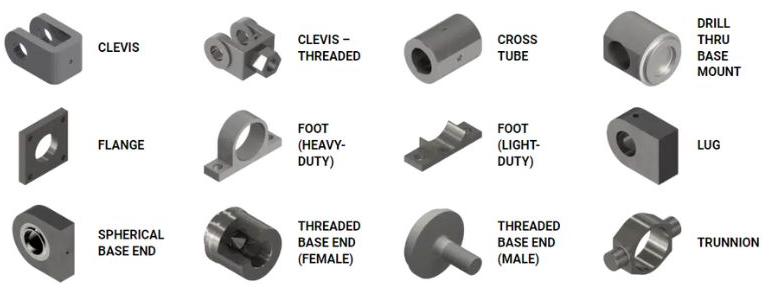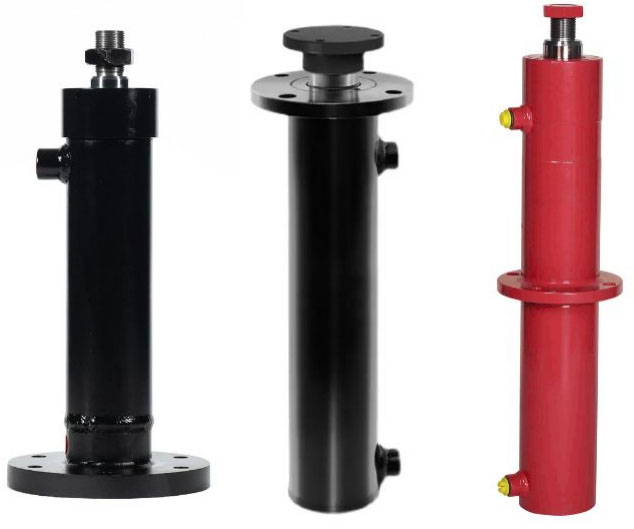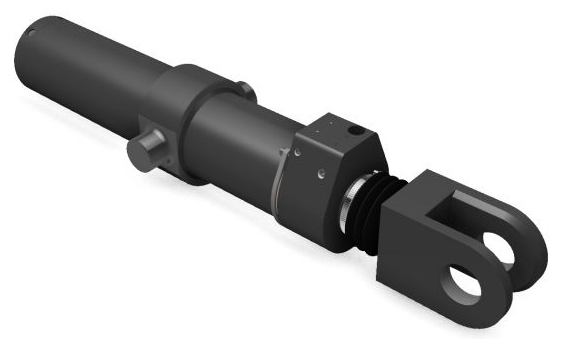The intricacies of hydraulic cylinder installation play a crucial role in determining the efficiency, safety, and functionality of machinery. The key to a hydraulic cylinder's performance lies in its installation, which can significantly impact both its effectiveness and longevity. In this comprehensive exploration, we will delve into the various types of mounting for hydraulic cylinders. Together, let's demystify hydraulic cylinder mounting and discover how the right choice can revolutionize your machinery's performance.

When it comes to hydraulic systems, the way a cylinder is mounted is more than just an attachment; it's a strategic decision that can define the success of your machinery's operation. Proper mounting ensures that a hydraulic cylinder operates at its peak efficiency, maintaining safety and reliability regardless of the conditions. This critical aspect is often overlooked, yet it holds the key to optimizing system performance. When a hydraulic cylinder is mounted appropriately, it harmoniously integrates with the machinery, leading to a seamless operation that stands the test of time.
Side-mounted hydraulic cylinders are distinguished by their mounting style, where the cylinder is attached at its sides, usually through a series of bolts or pins. This type of mounting is popular in various applications due to its simple design and ease of installation. These cylinders are commonly found in industrial machinery such as presses, plastic molding machines, and, in some cases, mobile equipment like excavators and loaders. Their design is particularly suitable for scenarios where there is ample vertical space, allowing the cylinder to be mounted horizontally.
1.Advantages:
• Ease of Installation and Maintenance: The accessible mounting points on the sides make these cylinders easy to install, adjust, or replace without requiring significant disassembly of the machinery.
• Stability: Side-mounted cylinders provide a high degree of stability, especially in applications where the load is consistently aligned with the cylinder's axis.
2.Limitations:
• Handling Side Loads and Off-Axis Forces: Side-mounted cylinders are not ideal for handling significant side loads or off-axis forces, as these can cause misalignment and increased wear on the cylinder, leading to reduced efficiency and a shorter lifespan.
• Space Constraints: In applications where horizontal space is limited, side-mounted cylinders may not be the best choice due to their design requirements.
Clevis mounted hydraulic cylinders are characterized by their unique clevis end, where the cylinder is attached to the machinery via a U-shaped or forked end. This clevis is connected to the machine using a pivot pin, allowing the cylinder to swing or pivot during operation. This mounting style is designed to accommodate angular motion, making it ideal for applications that require the cylinder to adjust its angle relative to the load.
The design of clevis mounts is inherently flexible, which helps in absorbing small misalignments that may occur due to load shifts or movements in the machinery. This flexibility reduces the strain on the cylinder, thereby extending its operational life.
Clevis mounts are particularly advantageous in applications where the cylinder needs to move in an arc or where angular movements are frequent, such as in agricultural equipment (e.g., tractors and harvesters), construction machinery, and certain types of industrial automation systems. They are also beneficial in applications requiring end-of-stroke cushioning to absorb shock loads, as the clevis mount can provide a degree of natural cushioning due to its design.
In addition to their flexibility, clevis mounted cylinders are valued for their ability to maintain alignment, which is critical in applications where precise movement is necessary. This alignment ensures consistent force application, leading to more accurate and efficient operation of the machinery.
When installing clevis mounted hydraulic cylinders, it is crucial to ensure that the pivot pin is properly sized and secured to avoid excess play or movement, which could lead to premature wear. It is also important to align the cylinder correctly with the pivot points to prevent binding or undue stress on the cylinder. Regular inspection and maintenance of the clevis, pivot pin, and mounting points are essential to ensure long-term reliability and performance.
Furthermore, when selecting a clevis mounted hydraulic cylinder, it is important to choose one with the appropriate bore size and stroke length that matches the specific demands of the application. This ensures that the cylinder can handle the required load and movement without overextension or underperformance.
Flange mounted hydraulic cylinders are distinguished by a flange, usually located at the head or base of the cylinder, which is used to attach the cylinder to the machinery. This flange is a robust, flat piece that can be bolted directly onto a surface, providing a secure and stable connection. Flange mounts are particularly known for their strength and ability to handle heavy loads, making them well-suited for industrial applications where the cylinder must withstand significant force or weight, such as in presses, cranes, and heavy-duty machinery.
One of the unique characteristics of flange mounting is its ability to withstand high forces in the axial direction while maintaining stability. This is due to the direct and rigid mounting surface, which minimizes movement and vibration during operation.
Compared to other mounting styles like side or clevis mounts, flange mounts offer superior stability and load capacity. The rigid, direct connection to the machine frame allows the flange mount to handle higher axial loads without risking misalignment or instability.
In contrast, side mounts, while offering ease of installation, may not be suitable for very high-load applications due to potential side-loading issues. Clevis mounts, on the other hand, provide flexibility for angular movement but may not offer the same level of direct force handling as flange mounts.

1. Head Flange Mounted Cylinders:
• These cylinders feature a flange at the head end, making them suitable for applications where the cylinder must resist strong longitudinal forces.
• The head flange mount provides a sturdy and stable connection, making it ideal for heavy-duty industrial applications.
2. Cap Flange Mounted Cylinders:
• In this configuration, the flange is located on the cap or base end of the cylinder.
• This type is beneficial when the cylinder needs to be mounted at the end of its stroke, offering a secure attachment point and good resistance to forces applied along the axis of the cylinder.
3. Intermediate Fixed Flange Mounted Cylinders:
• These cylinders have a flange mounted at an intermediate point along the cylinder body, rather than at the ends.
• This type is used in specific applications where the mounting needs to be positioned at a particular point along the cylinder for optimal force application and balance.
4. Double Flange Mounted Cylinders:
• Double flange cylinders have flanges at both the head and cap ends, providing extremely strong and stable mounting.
• They are ideal for applications involving high loads and where the cylinder needs to be firmly anchored in place.

Trunnion mounted hydraulic cylinders are distinguished by their unique design, which includes trunnions—protruding cylindrical mounts—located on either side of the cylinder body or on the cap and base. This design allows the cylinder to be mounted in a pivot-like manner, enabling it to swing or oscillate along the axis of the trunnions. The trunnion mount is effective at absorbing forces from multiple directions, particularly those perpendicular to the piston rod. This configuration is especially useful in applications where the cylinder needs to accommodate significant changes in angle during operation.
Trunnion mounts are highly versatile, making them suitable for a wide range of operating conditions. They are ideal for machinery that requires the cylinder to follow a curved path, such as in excavators, hydraulic presses, or rock crushers. This flexibility in movement also makes trunnion mounts a good choice for applications that experience significant shifts in load direction, as they can pivot and adjust to these changes, thereby reducing stress on the cylinder.
Additionally, trunnion mounted cylinders are often used in situations where space is limited, as they do not require additional space for mounting structures at the ends of the cylinder. This space-saving feature makes them an attractive option for compact machine designs.
Foot-mounted hydraulic cylinders are characterized by their mounting style, which includes a ‘foot’ or base at the bottom of the cylinder for attachment. This foot is typically a flat, extended part of the cylinder’s outer casing, allowing it to be bolted directly onto a flat surface. Foot mounting is a versatile and straightforward method, ideal for applications where the cylinder can be supported along its length, thereby reducing the risk of bending under load.
This type of mounting is particularly advantageous in applications where the cylinder needs to be mounted horizontally and supported along its length. It is a common choice for applications such as presses, material handling equipment, lifting devices, and certain types of manufacturing machinery where the cylinder does not experience significant lateral forces.
Foot-mounted cylinders have a significant impact on both the operation of the cylinder and the overall design of the machine. One of the key benefits of foot mounting is the distribution of force along the length of the cylinder, which helps in reducing stress and potential bending. This is especially important in applications involving long strokes or high forces.
In terms of machine design, the choice of foot mounting often leads to simpler designs, as it doesn’t require complex structures or additional space for mounting brackets. However, the design must ensure that the cylinder is adequately supported and aligned to prevent misalignment, which can cause uneven wear and reduced efficiency.
1.Rod Eye Mount: This type of mount features an eye at the end of the piston rod, enabling a pivoting connection. It is used in scenarios where angular movement is necessary, similar to clevis mounts but positioned at the rod end.
2.Pivot Mount: Pivot mounts are designed to allow the cylinder to pivot around a fixed point. They are ideal for applications that require a swinging motion.
3.Lug Mount: Lug mounts consist of protrusions (lugs) on the cylinder barrel, offering strong and secure attachment points. These mounts are commonly used in heavy-duty applications where the cylinder needs to handle significant loads.
4.Sphere Mount: Sphere mounts feature a ball-type joint at the mounting point, allowing for multi-directional movement. This type of mount is suitable for applications where misalignment might occur.
5.Nose Mount: Nose mounts are similar to head flange mounts but include a protruding, threaded nose at the head end. They are used for through-hole mounting in applications such as clamping and punching.
6.Universal Mount: Universal mounts are highly versatile and allow for mounting in various positions and angles. They are adaptable to different applications, providing flexibility in installation and use.
7.Welded Mount: In welded mounts, the mounting structure is directly welded to the cylinder, creating a permanent and robust connection. This type of mount is often used in custom applications where standard mounts are not feasible.
8.Tierod Mount: Tierod mounts utilize long, threaded rods that run the length of the cylinder, providing stability and ease of maintenance. They are commonly found in industrial applications.
9.Intermediate Fixed Trunnion Mount: This mount features trunnions located at an intermediate point along the cylinder’s body, providing a pivot point that is useful in applications requiring precise positioning.
Selecting the appropriate type of hydraulic cylinder mounting is both a technical and strategic decision. Ranging from robust, heavy-duty flange mounts to flexible, versatile collet mounts, each mounting type serves a distinct purpose and can be customized to meet specific operational requirements. As technology has advanced, so too have the solutions for hydraulic cylinder mountings, offering more efficient, reliable, and tailored options for a wide array of industrial applications. If you have any questions, please do not hesitate to contact HCIC!